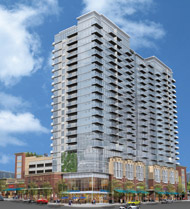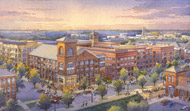|
COVER STORY, MARCH 2012
MULTIFAMILY PIPELINE HEATS UP
Despite uneven economic recovery, apartment developers are moving dirt.
Savannah Duncan
During the past few months, several new multifamily development projects have been announced, broken ground or opened in the Southeast. In the past month alone, Southeast Real Estate Business has reported on 11 multifamily projects in various stages.
“Investors and lenders are showing a lot of interest in new apartment developments throughout the Southeast,” says Dave Thompson, development director of Wood Partners. He is based in the company’s Boca Raton, Florida, office. “The economy has stabilized, and there’s a lower development cost and limited supply. All of those things combined deliver attractive returns for new projects.”
In a Southeast Real Estate Business survey published in December 2011, nearly 60 percent of developer respondents indicated they had projects in the pipeline in the Southeast that they would break ground on this year. More than one-fourth (27.8 percent) stated they intended to break ground on multifamily developments in 2012.
“There are a lot of great fundamentals [in the Southeast] that are drivers for continued prosperity in the multifamily sector,” says Pat Henry, chief development officer based in Daniel Corp.’s Birmingham, Alabama, office. “If you look across the Sunbelt, there are green shoots of economic activity and recovery that are substantial. We believe those are long term.”
Development Trends
Regardless of the type of multifamily project, there are a few development trends, such as upgraded interior finishes and more high-end amenities.
“Even though the homeownership rate is dropping, people’s standards are not,” says Bob Weston, Alliance Residential’s managing director of development for the Southeast. He is based in the company’s Atlanta office. “As people are choosing to be renters rather than owners, there’s a certain level of quality they expect.”
The shift in tenant expectations has led Woodfield Investments to focus on adding interior elements that are a step above apartments of the past.
“It’s rare to see the kind of product we build without granite countertops,” says Greg Bonifield, partner of Arlington, Virginia-based Woodfield Investments. “We’re very focused on giving tenants interior finishes, such as cabinets, lights, plumbing and fixtures that would be common in a nice custom home.”
Another trend Bonifield notes is a shift in the quality of amenities. “We continue to build better fitness centers with more equipment,” he says. “Also, we are putting in luxury pools with cabana areas and outdoor fireplaces.”
Connectivity and a sense of community are the newest amenity trends that developers must consider. Henry says residents connect differently today than they did during the heaviest part of the last development cycle, which has affected how Daniel Corp. approaches development.
Residents connect differently now than they did in the past due to a combination of two things: technology and overall profile change of the renter, says Henry. Technology is a major factor of the connectivity due to the use of smart phones and iPads, as well as social media, which has a profound effect on how developers organize a community.
“As the developer, you are the quarterback of pulling that community together,” he says. “We are focused heavily on offerings that build communities within our projects.”
Thompson adds that green elements and proximity to mass transportation are also important to today’s renters. All of Wood Partners’ projects are designed to become Energy Star certified, Thompson says.
“In March 2009, the leadership at Wood Partners issued a new energy policy stating that all of its new projects would be designed and constructed to achieve the Energy Star standard whenever possible,” he says. “The company’s push into green building came from evidence of demand from home renters who made it overwhelmingly clear in survey results that they wanted efficient living choices.”
On the finance side, Bonifield says multifamily lenders are active right now, but they are only lending to the best-in-class borrowers.
“Lenders want to give money to companies with a long track record of completing projects in a timely manner and on budget, and underwriting their projects correctly so they do well even if the economic circumstances change,” he adds. “From what I have experienced, banks are very willing to lend, but they want to make sure they are lending to the right people.”
Weston, on the other hand, says capital to finance new development is scarce, especially in Atlanta, where the metro area was overbuilt during the last development cycle and a plethora of vacant single-family homes remains.
“It’s harder and taking longer to raise capital,” Weston says. ”Especially in Atlanta, it is a scarce commodity.”
Activity in the Southeast
Since October 2011, projects have been announced in several states throughout the Southeast, including Arkansas, Alabama, Virginia and Maryland, but the majority of recent activity has been concentrated in Atlanta, Florida and the Carolinas.
In Atlanta, despite the glut of single-family homes competing for renters with the traditional apartment market, there are a few large projects under construction, particularly in the Midtown submarket.
 |
Daniel Corp. is developing the $82 million 77 12th Street, part of the firm’s
$1 billion 12th & Midtown project in the Midtown submarket of Atlanta.
The project will include 330 apartments and 20,000 square feet of retail. |
|
Currently, Daniel Corp. has three multifamily projects under construction in the Southeast at a combined cost of more than $200 million. The largest is the $82 million 77 12th Street, part of the firm’s $1 billion 12th & Midtown project in the Midtown submarket of Atlanta. The 23-story residential tower includes 330 luxury apartment units and 20,000 square feet of street-level retail space.
“Midtown Atlanta is an urban, street-oriented community that is heavily amenitized with a focus on the arts,” Henry says. “Our project really fits in with everything that is part of that vision.”
Daniel Corp. has entered into a contract to buy the 80-unit The Rocca: Piazza at Paces in Atlanta’s Buckhead submarket. This summer, the company will start construction to expand the property by 200 units.
Weston says that although Atlanta’s economy might still be struggling more than other gateway cities, the company is still bullish on the market. “Prior to the downturn, Alliance Residential was very focused on Atlanta,” he says. “We really like the story of infill in here, and I’d love to get a development started in Atlanta this year.”
Weston says 3,100 apartment units were started last year in Atlanta, including approximately 2,100 urban and infill units and about 1,000 garden-style units.
“A lot of people were surprised by the number since Atlanta has not recovered as quickly as many other major metropolitan areas,” he says. “Most of the starts were in submarkets that had seen limited new supply in recent years, or they were unique product types in highly desirable locations like Midtown.”
In February, a joint venture between Novare Group and Batson-Cook Development Co. broke ground on the $60 million, 320-unit SkyHouse Midtown, also in Atlanta’s Midtown submarket. Completion is slated for January 2013.
 |
Alliance Residential began work on its $62 million, 384-unit Broadstone at North Boca Village in November 2011.
The project is scheduled for completion in March 2013. |
|
Another market that has experienced an influx of development activity is Florida. Alliance Residential began work on its $62 million, 384-unit Broadstone at North Boca Village in November 2011, which is scheduled for completion in March 2013.
Thompson says Wood Partners has two projects it’s developing in Florida, and hopes to have two more under construction during the first quarter of this year.
In Orlando, the company is working on the $32.7 million, 264-unit Alta at Lake Eve, a luxury apartment complex scheduled to open in March 2013. Additionally, the $66.5 million, 369-unit Alta Congress is under construction in Delray Beach. The developer broke ground on the project in August 2011, and the first residents are expected to move in by December 2012, with the complex fully completed by May 2013.
Pollack Shores is also developing a property in Orlando. The developer broke ground in January on the $40 million, 326-unit Steele House Apartments. The first units will be delivered this fall.
A number of development projects are also taking place in the Carolinas. Bonifield says the demographics of the Carolinas are desirable to Woodfield Investments, which is working on four projects in North and South Carolina.
“We’re drawn to areas that have highly educated populations because that’s where the jobs tend to go,” he says.
Woodfield Investments broke ground in November 2011 on the 280-unit Woodfield Long Point in Mount Pleasant, South Carolina. In January, the company started construction on the 256-unit Woodfield Creekstone in Durham, North Carolina.
Most recently, Woodfield Investments formed a joint venture with Global Growth Trust to build a $30 million, 297-unit garden-style property in Charlotte, North Carolina.
The company is also working on Whitehall Parc in Charlotte, which broke ground in early March.
 |
Crescent Resources is developing the $47 million, 303-unit Circle Ninth Street
in Durham, North Carolina. The first units will be delivered in the fall. |
|
One of the largest projects taking place in the Carolinas is Crescent Resources’ $47 million, 303-unit Circle Ninth Street in Durham, North Carolina. The first units will be delivered in the fall. The property is one of four multifamily developments Crescent Resources started construction on last year.
While the uptick in multifamily development may raise some concerns about overbuilding, Bonifield believes that the space will be absorbed relatively quickly.
“There’s a whole echo boomer generation that understands the benefits of renting versus buying,” he says. “We also have to take into account that 75,000 apartment units a year go offline for myriad reasons. There is plenty of room for multifamily to continue to be a bright spot for several years to come.”
©2012 France Publications, Inc. Duplication
or reproduction of this article not permitted without authorization
from France Publications, Inc. For information on reprints
of this article contact Barbara
Sherer at (630) 554-6054.
|
